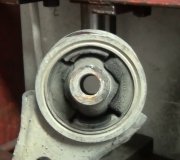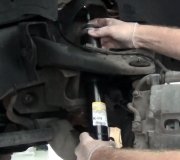The procedure isn't listed on our online service manuals, but that's okay. There's a much better way to go, both for you and for your customer. One boot alone is listed as costing over $66.00 from the dealer. Expect the kit with grease to cost roughly half of that from an auto parts store. Compare that to the cost of a new half shaft, complete assembly. The most expensive one from Rock Auto is only $71.00. Doesn't show if that's new or rebuilt, but I did buy a brand new one for my '88 Grand Caravan a few years ago for $65.00. Why pay just as much for only the boot, then have to go through the work of replacing it?
On a lot of imports, the inner cv joint can't be separated from the shaft. To replace an inner boot, you have to remove the outer joint and boot, then slide the new inner boot on from that end, then reassemble everything. It's a very messy job that's listed to take over 2 1/2 hours.
The steps to replace the half shafts are shown in the drawings below. Explain to your customer this will cost them less by requiring a real lot less labor time and give them a much higher quality repair. It will cost you about the same but make you a lot more profit with less mess and no special tools needed.
Note the warning at the top of the first page about placing no vehicle weight on the wheel bearing when the axle nut is loosened or removed. I've been preaching that to my students for years, but this is the first time I saw it in print.
If you're just starting out, learning on customers' vehicles is a real bad idea. Word of mouth advertising from an unhappy car owner can make for a bad reputation. Better to work in a shop first to get some experience. It isn't too hard to get hired at a new-car dealership, but it's the independent shops where you'll reach the pinnacle of success. The people there have to know all brands and models, not just the brands they sell.
A good thing at dealerships is you get factory training and you have access to special tools and information. At least up to a few years ago, there were a number of instructors who worked for Carquest to put on two-evening classes, usually eight hours total, once a month for the independent mechanics. Ours came from Chicago to northern Wisconsin each month. The instructor owns a shop that specializes in diagnosing the one out of a hundred cars no one else has been able to figure out. They network with other instructors including those who teach the manufacturer's classes. Most of his customers were other shops. Once they figured out the problem, they built a two-night class around that. The cost for those classes was $1200.00 per year as late as 2008. One of my fellow students drove over eight hours one way to attend each month. If you can get in at an independent shop that sends their employees to these classes, it will be free for you, and you'll learn a bunch.
Another alternative is to attend an Automotive Technology class at your local community college. Mine used to offer night classes in just one subject, and they had weekly night classes that were just an open shop for anyone in the community. That was to give back to the local tax payers. An instructor was always there to help and to answer questions, but there were no tests. The only requirement was to use some of the equipment, you had to be trained on it or show you knew how to use it.
If you pick a school to attend, be aware a few instructors are very rigid and will require you to work on the projects they choose. I was very flexible and allowed my kids to bring in anything related to the subject we were studying. I taught four classes per year, each eight weeks long.
As a side note, tech college instructors get textbooks every year from publishers in hopes we'll adopt them for our classes. Automotive programs can be certified by "NATEF", the same organization that certifies mechanics. One of their many requirements is textbooks can't be more than five years old. Authors will commonly rearrange a few chapters and add a little new information, then call it the next edition. The older editions are still relevant, but won't be used in class, so we often give them away. If you ask three different instructors, I'd bet at least two of them would be happy to unload a book or two to you. In this case, a Suspension, Steering, and Alignment textbook will cover cv joint and cv joint boot replacement for many different models.
Some of these textbooks cost students over $125.00 each, so grab a free one if you can.
I can't stress enough, if you try to start out in this field without working for someone else first, you'll be seriously short-changing yourself. In someone else's shop, you'll also run into a bunch of hard-working people, and there's always at least one complainer in the group. Don't let that whining and sniveling get you down. Just laugh at them or ignore them. And try to imagine how that makes the boss, manager, or shop owner feel. You'll learn what kinds of problems they have to deal with, and why they're willing to take on that grief to run a successful business.
There's also the mechanic who is protective of his knowledge, (or lack of it), and is unwilling to share it. Helping a new coworker to learn, or to finish a project correctly only helps that new guy. It doesn't take anything away from the person with the experience. Please consider in a few years being the fellow who helps the new guy get a start.
While I'm preaching, this is the perfect time to go slow and find a reputable shop to work in. In my city, we had my old Chrysler dealership, the nearby GMC dealer, the Cadillac dealer, the import dealer, and the former Ford dealer, who all worked together. We would borrow service manuals, fix each other's trade-ins, and help over the phone. The one notable exception is the Chevy dealer. He is a well-known crook. People who just have to have a Chevy commonly travel 15 or 30 miles to a dealer in a different city.
We also had one disreputable independent shop owner, but he ran out of customers in our extended community of over 100,000. Now he manages a franchise, and that shop's reputation is shot now too. Independent shops with the intent of getting rich by ripping customers off don't last very long. You want to be one of the good mechanics.
Okay, to continue, if you aren't familiar with "flat rate", you'll want to use that in your business as it's fair to you and to your customers. One page of the huge book is shown in this first drawing I posted. Think of a barber who has a set fee for a haircut. Doesn't matter if it takes him five minutes or if you come in with ten year's growth. Cost is the same regardless of how long it takes. Flat rate lists every job or additional part of a job with two time allowances. The shorter one is for warranty or dealership work. Parts aren't rusted tight yet and they know exactly which tools to grab. The longer times are for the rest of us. When you write an estimate for someone, that flat rate time will be the same as used by another shop. The only variable should be your hourly labor rate. If you gain lots of experience, invest in expensive special tools, and invest in training, you'll get the job done faster, but you still charge the same amount. You can do more jobs per day. On the other hand, if you run into trouble, or have to study a service manual, or run for parts, the customer still pays the same amount. By working for yourself, you can be under less pressure to hurry up the job.
As for your cotter pin question, don't try to do this on a daily basis out of a car. They just don't come big enough to haul everything you might need. Use a full-size van or a small truck with a box high enough to stand up in. Put a workbench with a vise in there along with a small parts cabinet. If you don't need a new cotter pin on today's job, you surely will in the near future.
I can't tell you how many times I drove 40 miles to a cousin's house to do a repair, then found I didn't have the right tool. Often I had to resort to making his $1.99 socket set work. As a professional, you're going to invest in high-quality tools with a lifetime warranty. If you break a tool, you may have to run to the store to get it replaced, but if you buy off the tool trucks, like Snapon, Matco, or Mac, they come to you, but you might have to wait up to a week. My friend who has an overgrown body / mechanic hobby shop has over 40 socket sets, all from Snapon and Matco. Every week he is investing in something new. That's been going on for over 20 years like that. Think of high-quality tools as making you money, not costing you money. Depending on where you are, consider watching for auctions where a shop is going out of business. You can pick up the same tools at a better cost, and they still have the warranty if you break one. Only problem is you'll be bidding against a lot of other people for those tools. If you spend just a little more for the same sets on the tool trucks, you'll build up good will with the salespeople, then they'll be more willing to help with problems when they can. I have all Mac sockets because they started me off with a lot of dandy discounts when I was getting started. Today I have one of Snapon's top salesmen living right across the highway from me, but he is well-known for not giving discounts. Fortunately I haven't needed to buy a tool for some time.
To build an inventory of uncommon parts that you're likely to need more than once, like oil filters, consider buying two for the next job. The second time that customer calls you back, you'll already have the parts and won't have to make a special parts run to a store first. When you use that second oil filter, buy two more the next time you visit the parts store.
I know I gave you more than you asked for. I always like to see business owners succeed. Let me know if you have other questions, and be sure to come back here with your next job.
If this job goes okay, please let me know how it went.
Images (Click to make bigger)
Wednesday, December 7th, 2022 AT 6:59 PM


















































































